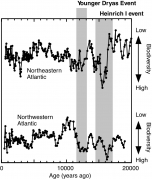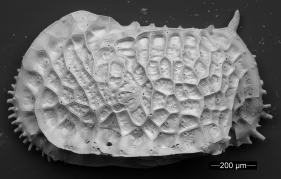Media
HKU ecologists discover how abrupt climate changes have impacted deep-sea biodiversity
29 Apr 2014
In online edition of Global Ecology and Biogeography, Drs Moriaki Yasuhara and Hisayo Okahashi (School of Biological Sciences, Swire Institute of Marine Science, and Department of Earth Sciences, The University of Hong Kong), in collaboration with US and Norwegian researchers, reported their discovery on abrupt climate change impact on deep-sea biodiversity. They showed that rapid changes in global deep-water circulation have affected biodiversity of benthic animals in deep-sea floor in the scales of decades and centuries.
There is robust evidence for human-induced global warming and its effects on ocean acidification, sea level and temperature. However little is known about its impact on deep-sea animals and biodiversity over long timescales. Using the exceptionally high-quality fossil record covering the last 20,000 years, Drs. Yasuhara and Okahashi and their colleagues discovered that past rapid climate changes over decades to centuries affected deep-sea biodiversity. More specifically, deep-sea biodiversity was increased during rapid climate change events characterized by surface-water and atmospheric cooling, including well-known "Heinrich 1" and "Younger Dryas" events (that occurred at 12,900–11,700 years ago and 17,000–14,600 years ago, respectively). These biodiversity changes are abrupt and pervasive, as they are confirmed broadly in the North Atlantic Ocean (see figure 1). For example, during Heinrich 1 event, diversity rapidly increases at the beginning and then shows characteristic double peaks both in northwestern and northeastern Atlantic sites, those are about 5000 km distant (figure 1). In addition, the biodiversity change shows 1,500-year periodicity, consistent with the well-known ‘1500-year climatic cycle’. Statistical modeling revealed that these diversity changes were most likely caused by reduction of global deep-water circulation, more directly by enigmatic deep-water warming during these rapid climate change events in the studied region. This discovery raises concerns that ongoing human-induced climate changes may trigger rapid reorganization of marine ecosystems even in the current century. Lessons learned from the sediment records of ocean circulation and deep-sea biodiversity have application to future ecosystem conservation and management of the world's oceans.
Dr. Yasuhara's research group uses fossil Ostracoda preserved in sediment core as a model organism to reconstruct biodiversity in ancient past, because this small (usually <1 mm) crustacean is very abundantly preserved as fossils even in small amount of sediment. All ostracode shells in sample were picked and identified to species level under microscope, and then species diversity was calculated. More than 100 species and 13000 shells are counted and identifies in a sediment core from the eastern North Atlantic Ocean in this study. Only these time-consuming works allow the researchers to reveal long-term biodiversity records hidden in fossils and sediments.
"Little is known about how marine biodiversity responds to which kind of oceanographic and climatic changes over decadal to centennial time-scales, that are most relevant for predicted climate changes due to greenhouse gas forcing. These time scales have been a kind of "Blind Spot" between biological and paleoecological studies, that are too long to be addressed by biological monitoring and too short to be resolved in ordinary fossil records", said Dr. Yasuhara. This study shows that exceptionally highly resolved fossil records could help our better understanding of past, present, and future ecosystems by bridging the gap between biological and paleontological time-scales.
For press enquiry, please contact Ms Cindy Chan, Senior Communication Manager of Faculty of Science, at 2241-5286/ 6703- 0212 or by email at cindycst@hku.hk; or Dr Moriaki Yasuhara, Assistant Professor of School of Biological Sciences at yasuhara@hku.hk
About the Research Paper
Journal: Global Ecology and Biogeography
Title: Response of deep-sea biodiversity to abrupt deglacial and Holocene climate changes in the North Atlantic Ocean
Authors: Moriaki Yasuhara (The University of Hong Kong), Hisayo Okahashi (The University of Hong Kong), Thomas M. Cronin (U.S. Geological Survey), Tine L. Rasmussen (University of Tromsø) and Gene Hunt (National Museum of Natural History, Smithsonian Institution).
Link of research paper: http://onlinelibrary.wiley.com/doi/10.1111/geb.12178/abstract
About the Journal
Global Ecology and Biogeography focuses on the emerging field of macroecology: the study of broad, consistent patterns in the ecological characteristics of organisms and ecosystems. The journal emphasizes studies that address general ecological hypotheses, explored and tested using data of broad geographic, taxonomic, or temporal scope.
For more information, please visit http://as.wiley.com/WileyCDA/WileyTitle/productCd-GEB.html
Image Captions
Please visit http://www.scifac.hku.hk/news/media?page=1 for pictures download.
Figure 1 is showing deep-sea biodiversity changes in northeastern and northwestern Atlantic Oceans for the last 20,000 years. Fossil records of these 50000 km distant sites show synchronous, rapid diversity increase during the rapid climate change events of Younger Dryas and Heinrich I (highlighted by gray). Higher biodiversity mean that there are more species in a sample.


